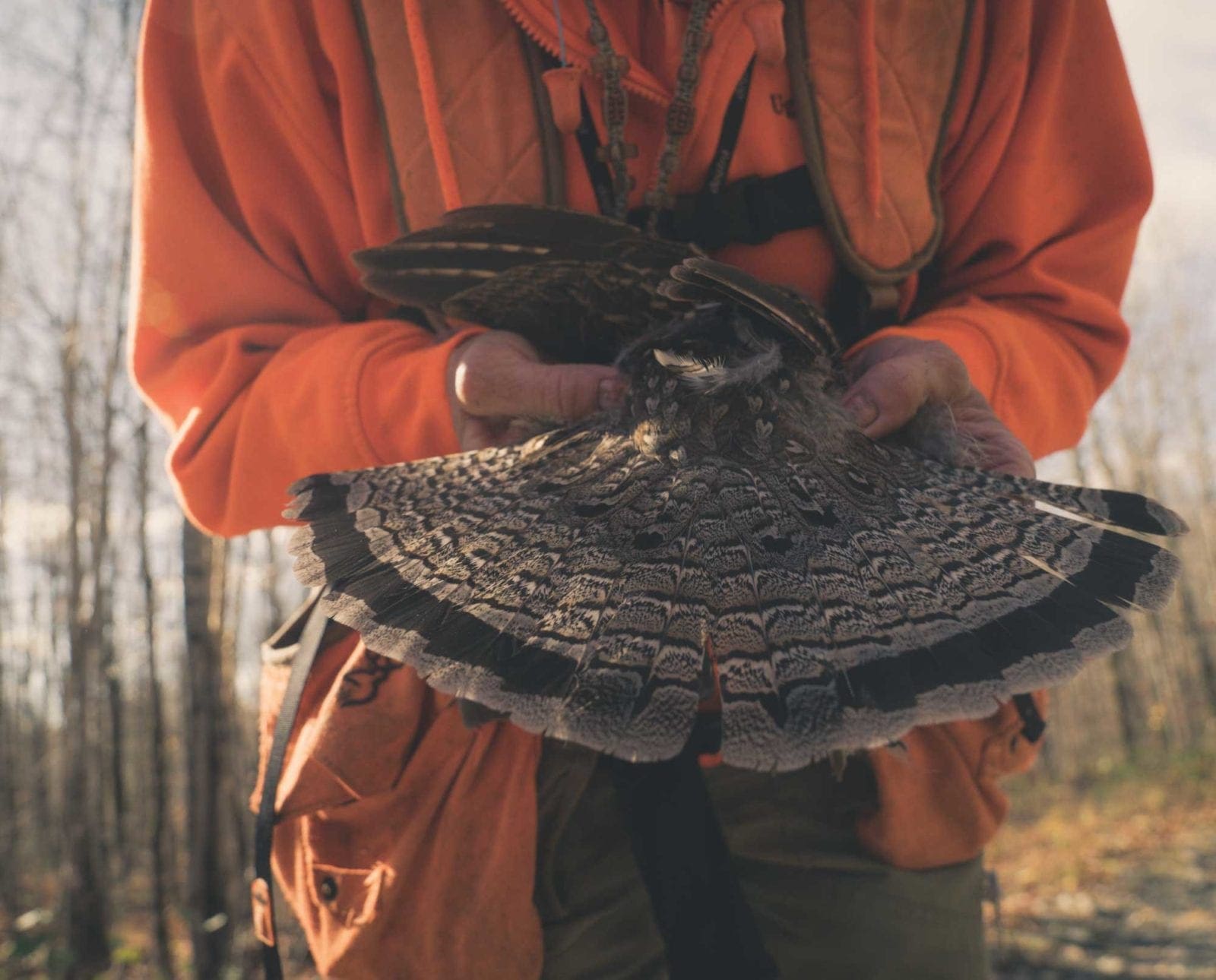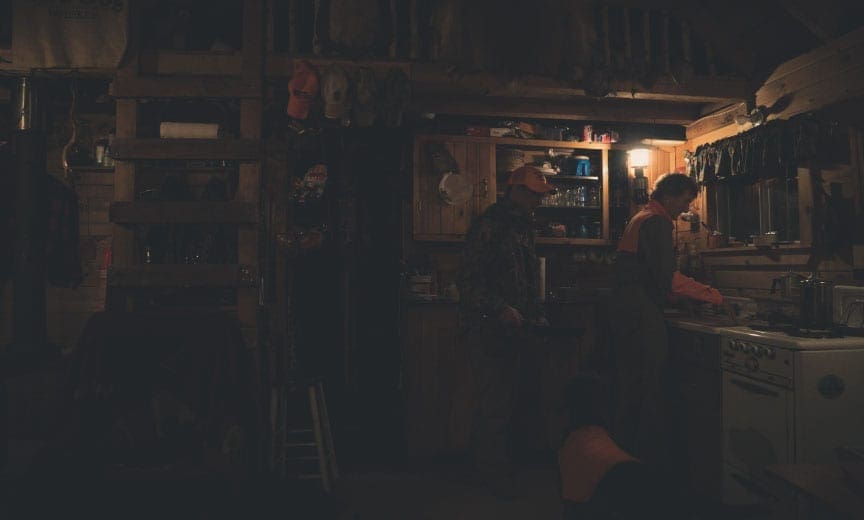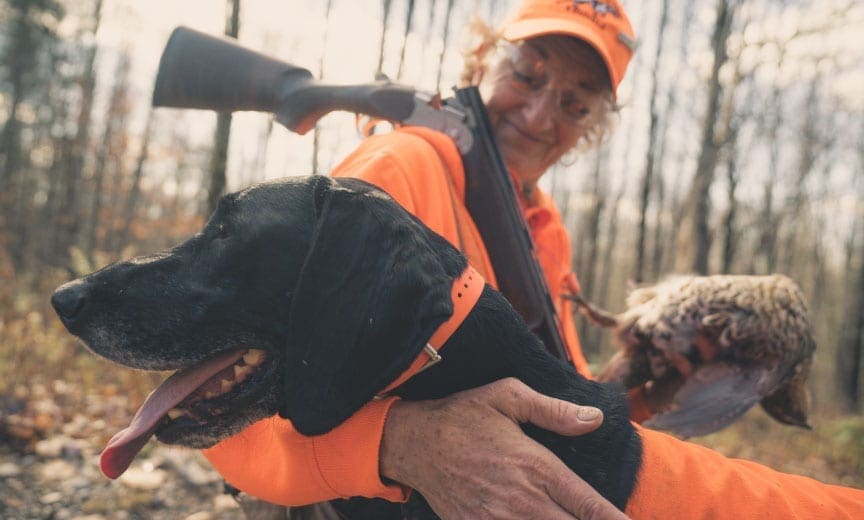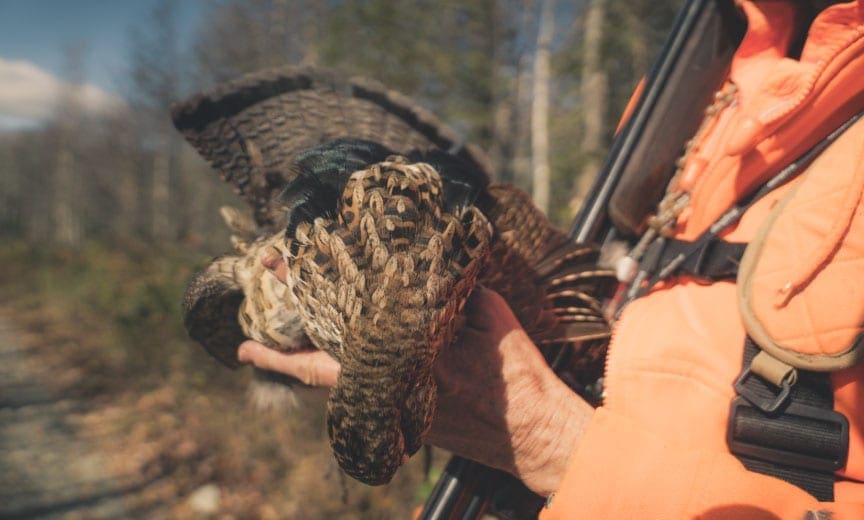Home » Grouse Species » Ruffed Grouse Hunting » Ruffed Grouse Hunting in Maine: The Season is Here
Ruffed Grouse Hunting in Maine: The Season is Here

Jason Carter is a NAVHDA judge, NADKC member, director of…
The author, a Maine native, explores ruffed grouse hunting tactics and scouting in the North Woods.
Are your senses tingling yet? The flutter of wings, the crunch of leaves beneath your feet, the sound of the dog bell falling eerily silent in the distance or that nostalgic odor of gunpowder? No? How about that smell of “swamp dog” permeating from your truck, the sharp sting of your ears from the cool temps paired with the crisp whip of a sapling or those late-night muscle spasms punishing you for the hills you traversed. Not ringing any bells? Let’s try the ever-present sound of defeat rattling around in your game bag, reminding you that you were once again outwitted by the King. I’m sure that might jog your memory. Yup, you guessed it, it’s grouse season!
I’ve been hunting ruffed grouse with my family ever since I could walk and likely a little before that as well. I’m by no means a wildlife biologist and everything I know has either been passed down to me by my father or discovered through overcoming my hunting failures in the woods.
As a kid growing up on grouse nuggets, I dreamed of someday being able to finally harvest one of my own. When I turned 10 my father gave me my first gun, which back then was always a hammer gun. Each day I would jump off the bus, run to my house and grab my 20-gauge single shot—then sneak up on an old apple tree at the corner of the property. Under that tree-like clockwork would explode what appeared to me at the time to be the world’s largest grouse just waiting to be mounted on my wall. I wish I could say that bird made it there. However, he enjoyed a long fruitful life free of any harm from me.

It took about eight more years of hunting before a Ruffy finally zigged when it should’ve zagged and I could finally put one in my hand. I remember it like yesterday, hunting alone with my parents’ 11-year-old, retired-to-them Versatile Champion German Shorthaired Pointer Britta. She had it pinned under a mass of tangled bittersweet. It came up and across in the classic station four low house crossing shot which I almost never hit, though down he came. Britta and I raced together to the bird and yes, there was some dancing, hooting and hollering for sure. Secretly, I may still do a fair amount of that to this day.
All that time with boots on the ground trying to figure out how to finally bring home the King has made me the grouse hunter I am. And yes, I still have that fan hanging in my home today. I love the challenge, the science and biology, I love Maine outdoors and the dog work that goes into hunting season . . . but I absolutely cherish the ruffed grouse.
Through NAVHDA and Merrymeeting Kennels, I have had the privilege to see many new friends evolve into upland grouse hunters. Though more often than not, I find folks struggle a bit to understand how to find their own coverts. With that, I’d like to share a few of my general techniques to find birds with those of you who are struggling to understand how.

Pre-Scouting for Ruffed Grouse
A ton of research can be done without stepping into the Maine woods, saving a ton of time and money. With the use of today’s technology, you can get a feel for your potential hunting grounds and predict with a fair amount of accuracy where your greatest concentration of birds can be found in that area. Simply take your areas and locate large swaths of previously logged forest. They are very distinctive on your imagery. Follow the line of old-growth abutting the younger 10-15-year-old growth. Where that line meets a water source and gravel, you’ll likely find birds. This is usually why I initially hunt every culvert I cross in the area—especially during droughts or warm weather. It also helps keep your dog cool on those early season hot days.
OnX Hunt
OnX Hunt has great satellite imagery, with fabulous tools to plan out a hunt. It provides landowner information which is essential for gaining access, being that 95 percent of our state is privately owned. You have the option of downloading maps so that you can still navigate and explore areas with no service. However, you must have Wi-Fi to download maps, requiring a fair amount of pre-planning.
Also, keep your phone away from your transmitter as it throws off the navigation feature of the app and you will soon find yourself “turned around.” Be sure to mark located birds on the map so that you’ll be able to later visualize productive areas and find similar forest diversity to hunt. When you get home that night and look at those bird locations, you’ll soon realize that it wasn’t just a random bird. There will be similarities in topography, direction, food sources, habitat and water resources. Oh yeah, and you can easily send your location and bird counts to your friends like me! I highly recommend purchasing this tool.
Google Maps and Google Earth
There is plenty of information to get you going from these free apps and websites as well. One of the most important features is that you are able to view areas from year to year and see the maturation of potential coverts, though they are nearly nonfunctional without service.
Read: Google Maps for Bird Hunting
Scouting for Ruffed Grouse
Once you’re physically in the area you’ll be able to better identify where the greatest concentration of birds can be found. What berries are ripe, what is budding or dropping, how wet is the ground, which trees dominate the landscape and how old they are. Look for raspberries and tamarack. It will indicate sufficient moisture on the ground. Look for a mixed forest that is young yet diverse with ample amounts of conifers. This will all play into good ruffed grouse habitat.
Find 10-15-year-old log yards with drumming logs and feeding undergrowth void of thick, tall grass. This year we are having a banner crop of beeches and acorns. I predict birds will go to these high-valued food sources early this year where normally this is a late-season food source. If you can find a covert mixed with birches, oaks, beeches, and conifers you may get into some good numbers. Open the crop of your grouse and refine your scouting to those food sources. If I’m on target here, the beech and oak ridges will make for some great shooting opportunities this fall.
The Biology of Grouse
The more you know about the biology of the grouse the better you will be able to predict their locations. Grouse, of course, don’t have teeth so they need gravel in their crop to eat. What age growth of trees do they prefer (no larger than a baseball in girth); what are they eating at that time; do they have dense conifers to roost and hide in? Is there hard mass (apples, beechnuts, acorn, etc.) feed to go to late season?
Remember that all game needs food, shelter, water and protection from predators and habitat. They will make a home in a small area and will have intimate knowledge of their escape routes, keeping them handy at all times. When a predator approaches they move into their escape route, and the moment they have a solid barrier between you and them they will take to the air, instantly placing those obstacles in between. Understand that their greatest threat comes primarily from above, making a dense canopy and thick forest essential in their survival. And that is also why the moment you see them, they vanish like ghosts.
The best strategy I tell folks to employ is not go to their dogs. Instead, rapidly get out and around the bird and walk back toward your dog. This takes their escape route away and encourages them to go into hiding, essentially pinning them and providing you with your best shooting opportunity.
Read: Understanding the Threat Response of Ruffed Grouse in Hunting
Another trick of the trade is to initially hunt every culvert as water and gravel are essential to grouse. However, grouse are very good at finding water in the gravel and need very little for their crops. That means they can get pushed back off the roads relatively easily in high-pressure areas and still live comfortably.

They are also edge creatures that follow the edges of cuts and can concentrate their numbers in areas that are rich in food supplies. After a flush, look around and you’ll likely find yourself in a corner or a point of sorts near water and gravel. Pay close attention and over time, like your dog, you’ll begin to see patterns and similarities to help better hone your skills at finding grouse. Lastly, try to follow the grain of the forest. Trees, of course, grow towards the sun creating natural travel corridors. Fighting the covert all day leads to some tired legs and poor shooting opportunities. Staying in the openings increases your potential of harvesting a bird and not cramping up before the end of the day.
If it’s for the gun dogs, for the ultimate challenge or for camaraderie of friends and family, ruffed grouse hunting in the Northeast is a passion shared by many, bringing outdoorsmen and outdoorswomen here from all over the country to get a chance at bagging the King of all game birds in some of the most difficult terrain. As you all know far too well, grouse hunting is not for the faint of heart. The struggle is real and most will take any suggestions that you might give them.
However, in general, grouse hunters tend to be a bit tight-lipped about their coverts and what they learn from year to year about their coveted birds in their area. To be fair, they burned a lot of leather to acquire that knowledge and earn the privilege of knowing what they know—and they have the right to share that information at their discretion. That being said, I love sharing my experiences and knowledge with others. Some of my most memorable moments have come from taking out youth and new hunters and watching them blaze away. Very few, however, are capable of returning with a grouse they’ve shot over a pointed dog.
For those lucky few fortunate enough to achieve that right of passage, I make sure to partake in their excitement, whether it be the grouse shuffle, high fives, hugs or a full-on hootenanny. I share the moment with them and let them know how treasured a moment they are experiencing, being sure to take the time to analyze the bird in its beauty, rehashing everything that led up to that moment. It’s something that was passed down to me, and I find it very important to pass along to others.
So get out there and explore your areas. Investigate flushes and study those crops and I promise your hard work will pay off. Then once you have it all figured out, give me a call and we can investigate those spots more thoroughly together.
Jason Carter is a NAVHDA judge, NADKC member, director of youth development, secretary of NAVHDA’s youth committee, clinic leader and trainer at Merrymeeting Kennels. He has been around versatile hunting dogs his entire life, literally! Born into the Carter family and Merrymeeting Kennels, he attended his first NAVHDA test in Bowdoinham, Maine, when he was just a year of age. Jason successfully trains, tests and breeds Deutsch Kurzhaars in both the NAVHDA and NADKC testing systems. Through his work at the kennel, Jason has had the opportunity to develop pointers, flushers and retrievers over the years. When October arrives he can be found with family and friends hunting throughout New England.



